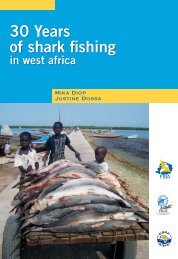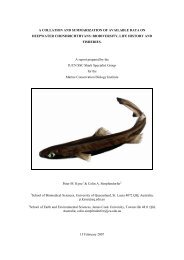Abercrombie et al_Fi..
Abercrombie et al_Fi..
Abercrombie et al_Fi..
Create successful ePaper yourself
Turn your PDF publications into a flip-book with our unique Google optimized e-Paper software.
Night shark (Carcharhinus signatus)<br />
Distribution: Widely distributed in warm temperate to tropic<strong>al</strong> regions.<br />
Habitat: Primarily offshore. Mostly taken in pelagic fisheries.<br />
Pector<strong>al</strong> fin description<br />
The dors<strong>al</strong> surface of the<br />
fin is light brown or greyishbrown<br />
in color with a dusky<br />
slight coloration on the ventr<strong>al</strong><br />
surface of the fin at the apex.<br />
Moderately long fin, tapering<br />
towards a pointed apex. The<br />
trailing edge is slightly f<strong>al</strong>cate.<br />
Similar species: Dusky pector<strong>al</strong> fins are extremely similar in shape, color and denticle size, but the<br />
free rear tip is narrower at the apex. Sandbar pector<strong>al</strong> fins are similar in shape and color, but have<br />
larger denticles on the dors<strong>al</strong> surface. Silky, night, bull and Caribbean reef pector<strong>al</strong> fins (not included<br />
in guide due to lack of sufficient samples for comparison) are similar in shape, but have more obvious<br />
dusky markings on the ventr<strong>al</strong> surface. Great hammerheads have a similar dusky coloration<br />
on the ventr<strong>al</strong> surface, but the apex of the is more pointed and the trailing edge is more f<strong>al</strong>cate.<br />
44
















